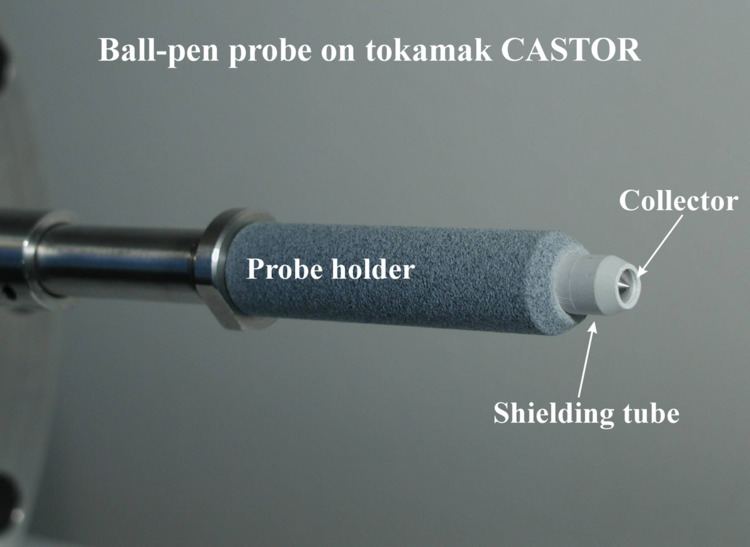 | ||
A ball-pen probe is novel technique used to measure directly the plasma potential in strongly as well as weakly magnetized plasmas. The probe was invented by Jiří Adámek[17] in the Institute of Plasma Physics [18] AS CR in 2004. The ball-pen probe balances the electron saturation current to the same magnitude as that of the ion saturation current. In this case, its floating potential becomes identical to the plasma potential. This goal is attained by a ceramic shield, which screens off an adjustable part of the electron current from the probe collector due to the much smaller gyro–radius of the electrons. First systematic measurements have been performed on the CASTOR tokamak. The probe has been already used at different fusion devices as ASDEX Upgrade, COMPASS[19], ISTTOK, MAST, TJ-K,[20] RFX [21], H-1 Heliac, IR-T1 as well as low temperature devices as DC cylindrical magnetron in Prague and linear magnetized plasma devices in Nancy and Ljubljana.
Contents
How the ball-pen probe measures the plasma potential
If a Langmuir probe (electrode) is inserted into a plasma, its potential generally lies considerably below the plasma potential
and the coefficient
The ball-pen probe, in magnetized plasma, modifies the collecting areas for electrons and ions and makes the ratio
The ball-pen probe inserted into the magnetized plasma is directly on the plasma potential without additional power supplies or electronics.
The ball-pen probe design
The design of the ball-pen probe is shown in the schematic picture. The probe consists of a conically shaped collector (non-magnetic stainless steel, tungsten, copper, molybdenum), which is shielded by an insulating tube (boron nitride, Alumina). The collector is fully shielded and the whole probe head must be oriented perpendicularly to the magnetic field lines. It is necessary to find the sufficient retraction of the ball-pen probe collector in order to reach
1) the ball-pen probe collector is biased by swept voltage (low frequency) to provide the I-V characteristics and see the saturation current of electrons as well as ions. The ball-pen probe collector is systematically retracted until the I-V characteristics become symmetric. In this case, the ratio
2) the ball-pen probe collector is fully floating. The ball-pen probe collector is systematically retracted until its potential saturates at some value, which is above Langmuir probe potential. The floating potential of the ball-pen probe remains almost constant for deeper positions too.
The electron temperature measurements without power supply
The electron temperature can be measured by using ball-pen probe and common Langmuir probe with high temporal resolution in magnetized plasma without any external power supply. The electron temperature can be obtain from previous equation, assuming Maxwellian plasma
The value of coefficient
where
The coefficient
